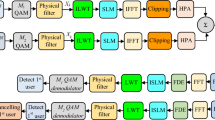Abstract
Orthogonal frequency division multiplexing (OFDM) technique has been widely used in visible light communications (VLC) system (VLC-OFDM). To minimize the performance degradation of VLC-OFDM system caused by high peak-to-average power ratio (PAPR), we propose a SFLAHC-PTS technique to reduce the PAPR of signal in this paper. The proposed SFLAHC-PTS is an improved PTS technique which takes advantages of shuffled frog leaping algorithm and hill-climbing algorithm to optimize conventional PTS technique, reducing the computational complexity of conventional PTS technique. We compare SFLAHC-PTS technique with other PTS techniques on the CCDF performance, as well as computational amount to analyze the superiority of SFLAHC-PTS technique. The results show that the proposed technique can greatly reduce the computational load of conventional PTS technique and has better performance in reducing PAPR than GA-PTS, SFLA-PTS technique.








Similar content being viewed by others
References
Komine, T., & Nakagawa, M. (2004). Fundamental analysis for visible-light communication system using LED lights. IEEE Transactions on Consumer Electronics, 50(1), 100–107.
Afgani, M. Z., Haas, H., Elgala, H., & Knipp, D. (2006). Visible light communication using OFDM. In 2nd international conference on testbeds and research infrastructures for the development of networks and communities (Vol. 6, p. 134).
Elgala, H., Mesleh, R., Haas, H., & Pricope, B. (2007). OFDM visible light wireless communication based on white LEDs. In IEEE 65th vehicular technology conference (pp. 2185–2189).
Jiang, F., Deng, H., Xiao, W., Tao, S., & Zhu, K. (2015). An ICA based MIMO-OFDM VLC scheme. Optics Communications, 347, 37–43.
Liang, W., Chen, Z. Z., & Ping, L. H. (2013). MIMO-OFDM visible light communications system with low complexity. In 2013 IEEE international conference on communications (ICC) (pp. 3933–3937).
Xin, Y., & Fair, I. J. (2004). Multiple-shift complementary sequences and their peak-to-average power ratio values. In ISIT 2004. Proceedings. International symposium on information theory (pp. 121–121).
Ali, A., Al-Rabah, A., Masood, M., & Al-Naffouri, T. Y. (2014). Receiver-based recovery of clipped OFDM signals for PAPR reduction: A Bayesian approach. In IEEE Access (pp. 1213–1224).
Jeng, S. S., & Chen, J. M. (2011). Implementation of low-complexity companding technique for efficient peak-to-average power ratio reduction in orthogonal frequency division multiplexing systems. IET Communications, 5(2), 154–162.
Cha, S., Park, M., Lee, S., Bang, K.-J., & Hong, D. (2008). A new PAPR reduction technique for OFDM systems using advanced peak windowing method. IEEE Transactions on Consumer Electroni, 54(2), 405–410.
Rahmatallah, Y., & Mohan, S. (2013). Peak-to-average power ratio reduction in OFDM systems: A survey and taxonomy. IEEE Communications Surveys and Tutorials, 15(4), 1567–1592.
Bandara, K., Niroopan, P., & Chung, Y. H. (2013). PAPR reduced OFDM visible light communication using exponential nonlinear companding. In Proceedings of IEEE international conference on microwave, communications, antennas and electronic systems (COMCAS) (pp. 1–5).
Deng, H., Sun, Y., & Yang, C. (2013). A new method to reduce peak to average power ratio in optical OFDM communication. Science Journal of Physics. doi:10.7237/sjp/166.
Xiao, W., Deng, H., Jiang, F., Zhu, K., & Yin, L. (2015). Peak-to-average power ratio reduction in orthogonal frequency division multiplexing visible light communications system using a combination of genetic algorithm and hill-climbing algorithm. Optical Engineering, 54(3), 036106-1–036106-9.
Kim, S.-S., Kim, M.-J., & Gulliver, T. A. (2006). A new PTS for PAPR reduction by local search in GA. In International joint conference on neural networks (pp. 2370–2373).
Zhou, J., Dutkiewicz, E., Liu, R. P., Fang, G., Liu, Y., & Huang, X. (2006). A modified shuffled frog leaping algorithm for PAPR reduction in OFDM systems. In IEEE region 10 conference (pp. 1–6).
Acknowledgments
This work was financially supported by Natural Science Foundation of China (Grant Nos. 61172047 and 91123035), Xinjiang Provincial Natural Science Foundation (Grant No. 2013211A035), Open Foundation from Metal Resources Strategic Research Institute of Central South University, and Hunan Provincial Natural Science Foundation (Grant No. 14jj2013).
Author information
Authors and Affiliations
Corresponding author
Rights and permissions
About this article
Cite this article
Xiao, W., Deng, H., Li, Y. et al. PAPR Reduction in VLC-OFDM System Using a Combination of Shuffled Frog Leaping Algorithm and Hill-Climbing Algorithm. Wireless Pers Commun 97, 3757–3771 (2017). https://doi.org/10.1007/s11277-017-4697-y
Published:
Issue Date:
DOI: https://doi.org/10.1007/s11277-017-4697-y




